It all starts one day at the Daily Star (yes, the Star, not the Planet-- and the nameless editor is definitely not his graying eminence Perry White, but a much younger brown-haired man), where Clark Kent, the "meek ace" reporter meets Nick Williams, who bills himself as Superman's personal manager. This comes as a shock to Kent, because he's secretly Superman. Then Kent receives another shock-- Williams is using Superman's good name to make money! Suddenly there's a Superman radio show, a Superman brand gasoline and even a Superman automobile, plus.any number of other shoddy products bearing the familiar S-logo, all illegally licensed by Williams. Most alarmingly, Williams openly threatens the world with what he claims is a deal for comic book appearances (and movies based on them, no doubt). Kent quickly arranges a meeting with Williams's client Superman, but he doesn't count on Lois Lane, who soon finds out about it and makes a plan of her own.
The first step involves allowing Kent to take her on a date to what we're told is a "famous night spot," so hoity-toity Kent has to wear a top hat. It's in the rarefied atmosphere of big city nightlife among the elite they witness this spectacle:
The second step involves this:
Yes, you just witnessed Lois Lane slip Clark Kent a mickey finn. She doesn't even know his body weight or what other medications he might be taking (both Marilyn Monroe and Anna Nichole Smith had chloral hydrate, the traditional "knock out" drug, among others in their systems when they died and it was a component of the lethal Kool-Aid at Jonestown; Lane would have been familiar with chloral hydrate from her police reportage even in the 1930s), so there's a small but very real chance she's killed him with an accidental overdose.
Of course Superman is just pretending. The drug doesn't work on his alien physiology (not that Lois knows this-- she's completely unconcerned she might succeed in her plan and still wind up facing a murder rap). While Superman's understandably miffed at having been drugged, that's no excuse for his sexist generalization. Unless in the 1930s all newspaper women actually did go around drugging their dates for reasons of professional gain and personal curiosity. If so, this was a dark era in American journalism.
Once she meets Williams and his ersatz Superman, it takes Lois Lane about two seconds to see through their lies. This woman is not only scary, she's scary-smart.
As unscrupulous as Lois is, Williams outdoes her with his willingness to commit outright murder. She lacks morals, he's actively immoral. Not for him Lois Lane's involuntary manslaughter. She threatens his finances, so out the window she goes. Well, we all know how this ends. Not with Lois Lane pulped on the sidewalk, but with her safely enfolded in Superman's mighty arms. And he treats her sneeringly.
Hmm. I'm starting to believe it's not just Lois. Despite its bright primary and secondary colors, Superman's world is in fact a noirish cesspool full of desperate, hateful people who would be right at home among the compromised denizens of James Ellroy's behaviorally miasmic Los Angeles. It seems no one is to be trusted and everyone possesses suspect motives and moral relativism. But that can't be true, right? These are adults. What of the young? Can we look to them to restore our belief in humanity's basic goodness? Let's go back to the story's beginning and find out.
Office boy Jimmy Olsen!* You eavesdropping imp! Behavior no doubt learned from his elders. But these are reporters and con artists, society's lowest echelon, of like kind right down there with pirates and mimes. What of its highest, our legal authorities? Surely writer Siegel will portray them in a positive light and balance out all these depressingly sordid people. As paragons of virtue, protectors of our mores and the angels of our better nature. This was the Golden Age, a time where we placed unwavering trust in a government that so recently assured us the only thing we had to fear was fear itself and our adventure comics told simplistic tales of the stark dichotomy between good and evil...
*Comixology and a few other sources list Action Comics #6 as Olsen's first appearance, but as far as I can tell this little spying bastard is as nameless as the paper's editor. Factor in his blonde hair, and he's more like Jammy Olson or Jackie Olaff than the more familiar cub reporter of Superman legend. This punk isn't even wearing a checked jacket. And he has a disturbingly infantile face. I conclude this isn't Jimmy Olsen at all, just a prototype character used to get Lois into the story, then discarded.

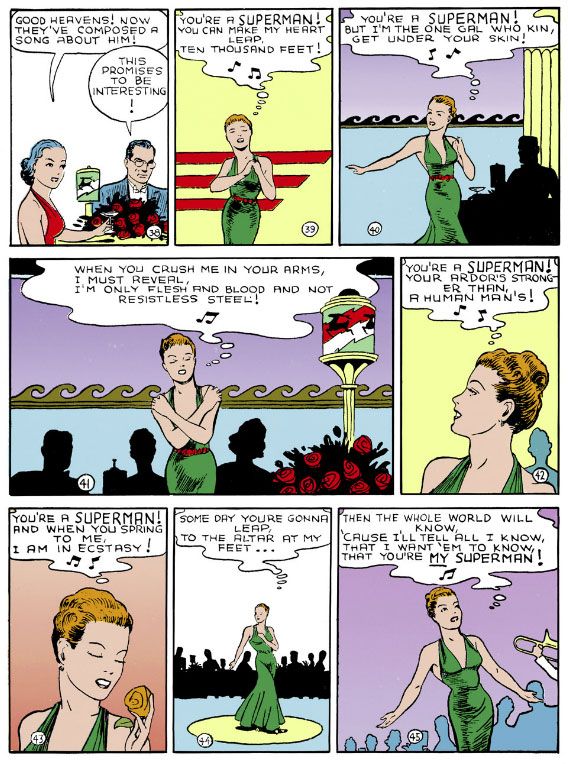
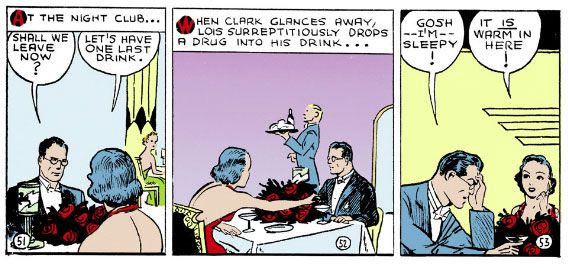

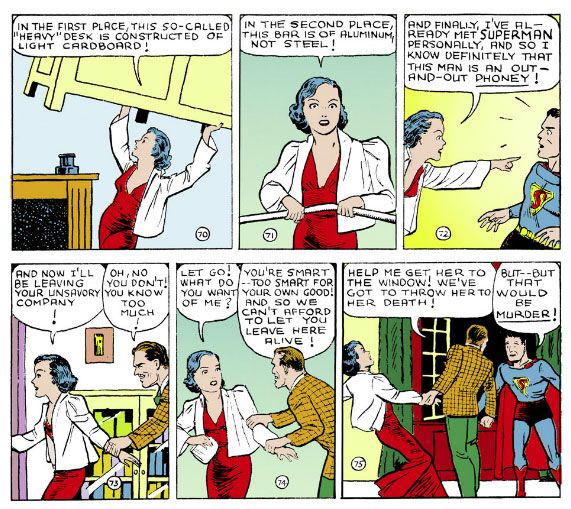
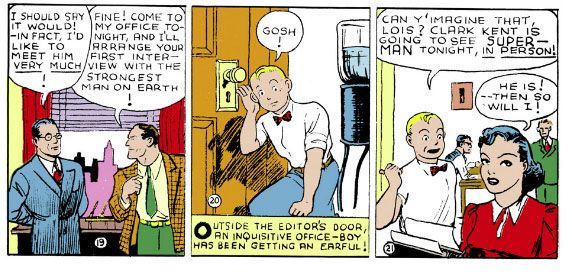
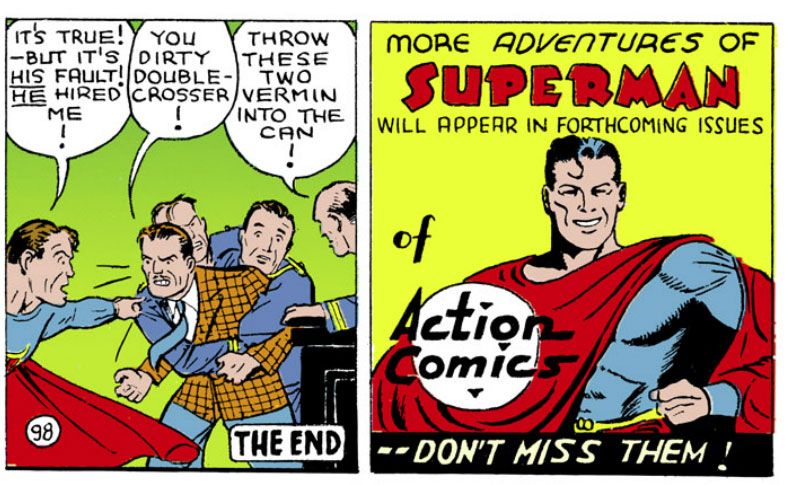
2 comments:
See, that's the Lois I love. If her creator got his ideas about knockout drops from Thirties screwball comedies, he also looked to the same source for his ideas about smart, tough talking, capable women with a line in snappy patter who didn't take guff from nobody. A bit of Barbara Stanwyck, a bit of Kate Hepburn, don't you think?
That copy boy, though, I'm trying to figure out if he's Moon Mullins or Skeezix.
Stanwyck and Hepburn, absolutely! She's the best. I've always liked Lois but getting a chance to read these first issues she really jumps out of them as a vividly realized ass-whupper in her own right. She may not fly or bounce bullets off her head like Superman, but she's definitely his match in will and determination. I don't get the slightest sense this version of Lois loses any sleep at night whether she's drugging Clark to get a scoop or writing about a steetcar accident with no survivors after witnessing its aftermath firsthand. I think it was in Slaughterhouse-Five Vonnegut has a great anecdote about calling in gory stories to his newspaper and talking to what must have been Lois Lane's soul sisters.
The copy boy is now Skeez Mullimoon.
Post a Comment